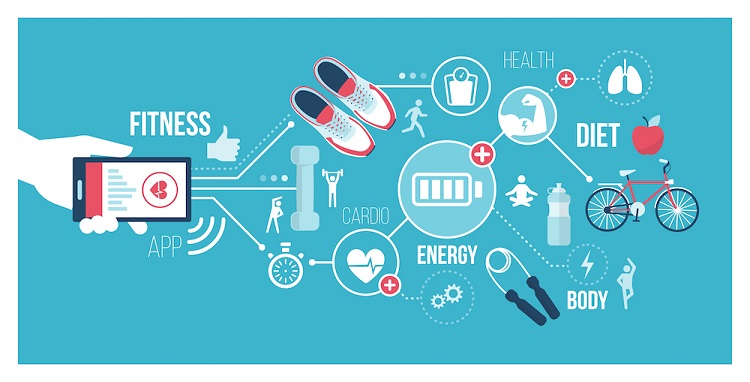Digital Fitness Sees Nike, Zwift, Peloton Leading Way

Additional Highlights from McKinsey’s Fitness Focused Annual Report; Experts predict the continued acceleration of exercise apps, overhauls in retail models and increased application or data-driven advertising.
For sports and fitness brands, 2020 was the year everything — instruction, sales of goods and marketing — moved online. The shifts were necessities as the COVID-19 pandemic closed or made consumers cautions about public places like gyms and fitness studios and retailers and also upended the schedules of sporting events that had been prime advertising venues. A new report from the World Federation Sporting Goods Industry and a partnering consulting firm, McKinsey & Company, says that many facets in the transition to digital fitness are irreversible.
The Acceleration of Digital Fitness
Use of digital fitness services bloomed after lockdowns, an unsurprising finding in “Sporting Goods 2021 – The Next Normal for an Industry in Flux.” According to one survey of U.S. gym members (one representative of other research into such consumer behaviors) the percentage of users who streamed classes increased from 16 to 48 during lockdown, those who used free apps bumped up from 13 to 44 and those used paid apps from 9 to 26. These practices continued after restrictions eased.
Customers were not as satisfied with the paradigm. In one pre-COVID survey, 70 percent of gym members said they were satisfied with their fitness routines, a figure that diminished to 37 percent during lockdown. The report authors expect that many users will eventually return to the gym, though 63 percent of executives surveyed predicted that the ranks of gym members would never be as large as it was pre-COVID-19.
All indicators point to digital offerings as growing, permanent parts of fitness routines; 60 to 80 percent of respondents in a survey said they will stick with fitness apps after the pandemic.
Building Community Virtually
One lesson to be taken from the COVID-19 shift is that online services did well by creating not just workout videos but a semblance of community. The report lists Nike, Zwift and Peloton as some “big winners” of the period. Their offerings diverge — Nike has a series of fitness apps, Zwift virtual biking and running backdrops and Peloton internet-connected status symbol stationary bikes — but they all increased sales with established networks of digitally connected users.
“[D]igital and fitness and related offerings — especially those offering community and incentive elements — are likely to continue to perform well in the coming period,” the report concludes. “Winners will focus on these, and then translate engagement into sales.”
Pivoting Business Models to Address Customer Needs
The future looks even more altered for sellers of fitness goods, sportswear and related merchandise. Prior to the pandemic, online sales growth averaged at around 2 percentage points a year, the report states; this figure increased to 16 points in six months because of the pandemic. Some consumers began buying such items online and those who already were filling digital shopping carts for fitness purchases used online options more often. In one survey, 28 percent of respondents said they will reduce their use of brick-and-mortar stores.
For brands that sell physical merchandize, this will necessitate rethinking everything.
“In the past, it was often sufficient for companies to focus on wholesale and then add a [direct-to-consumer] e-commerce offering,” the report states. “In future, that is unlikely to be enough. Companies must transform the fundamentals of their business model, which means creating an engaging digital store and aligning the company’s strategy, and business and operating models, with digital ways of working. This will require a shift in culture and mindset and must be backed by digital expertise to enable an agile response to fast-changing consumer needs.”
Shifts in Marketing & Advertising
The vanishing of crowded spaces also had profound implications for the marketing and advertising of sports brands. “The traditional tool kit for sports marketing comprised of team kit sponsorship, A-boards, branded adverts, traditional media, licensed products, merchandising and naming rights,” the report states. Many of these options were diminished as COVID-19 caused the cancelation or postponement of sporting events that were advertising hotspots, including the 2020 Olympics.
This will mean that audiences will have to be reached — you guessed it — online. The report recommends fine-tuned, data-driven campaigns that allow “brands [to] adapt stories based on consumer responses, news flow, team results, or even the weather.” Previously, such campaigns were used to drive immediate sales, but factors like awareness, credibility and engagement, which used to be communicated on the field, might have be driven online.
The Power of the Athlete
Many sports stars have public personas that extend beyond games. They are involved in causes or are representatives of changes in their field. The reports notes that though his leadership of the take-the-knee movement made him untouchable to NFL teams, Colin Kaepernick did wonders to promote Nike as a socially aware brand. Puma produced videos discussing racism starring sports stars, and Columbia Sportswear chose African-American NASCAR driver Darrell “Bubba” Watson as its brand ambassador.
In a survey, 72 percent of sports fans believe that “athletes provide a unique view and are an important influence.” Aligning one’s brand with a message that reflects aspired company values, the report states, is a way to continue to engage and identify consumers when there isn’t a game on.
Nick Keppler is a freelance journalist, writer and editor. He enjoys writing the difficult stories, the ones that make him pore over studies, talk about subjects that make people uncomfortable, and explain concepts that have taken years to develop. Nick has written extensively about psychology, healthcare, and public policy for national publications and for those locally- based in Pittsburgh. In addition to Athletech News, Nick has written for The Washington Post, The Daily Beast, Vice, Slate, Reuters, CityLab, Men’s Health, The Gizmodo Media Group, The Financial Times, Mental Floss, The Village Voice and AlterNet. His journalistic heroes include Jon Ronson, Jon Krakauer and Norah Vincent.



